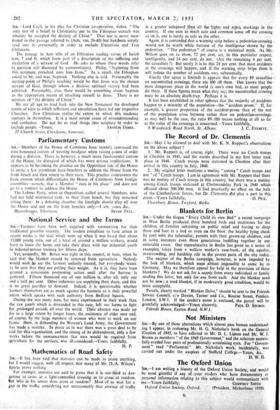o f Mathematics ot Road Safety SIR.—It has been said that
statistics can be made to prove anything, but I would suggest, with all respect, that many of Mr. D.-A. Wilson's figures prove nothing.
For example, statistics are said to prove that it is one-third as dan- gerous to cross at a light-controlled crossing as to ,cross, at random. But who in his senses does cross at random? Most of us wait for a pp in the traffic. considering not unreasonably that absence of traffic is a greater safeguard than all the lights and zebra markings in the country. If one uses as much care and common sense off the crossing as on it, one is surely as safe as the other.
Again, it is contended that a warning strip before a pedestrian-crossing would not be worth while because of the intelligence shown by the pedestrian. "The pedestrian" of course is a statistical myth. As lir. Wilson goes on to show, 72 per cent. act, in this particular respect, intelligently, and 24 per cent. do not. (Are the remaining 4 per cent. the casualties ?) But surely it is to this 24 per cent. that most accidents at the crossings will happen, and if the warning strip helps them it will reduce the number of accidents very substantially.
Finally (for space is limited) it appears that for every 89 casualties. on uncontrolled crossings, there are 100 off them. One knows that the most dangerous place in the world is one's own bedb as most people die there. If these figures mean what they say, the uncontrolled crossing must be an absolute death-trap. Perhaps it is.
It has been established in other spheres that the majority of accidents happen to a minority of the population—the "accident prone." If, for example, a greater proportion of the accident-prone than of the rest of the population cross between rather than on pedestrian-crossings, as may well be the case, the ratio 89:100 means nothing at all so far as the value of the crossings is concerned.—Yours faithfully.
9 Woodstock Road North. St. Albans. J. C. EVERETT.


































 Previous page
Previous page